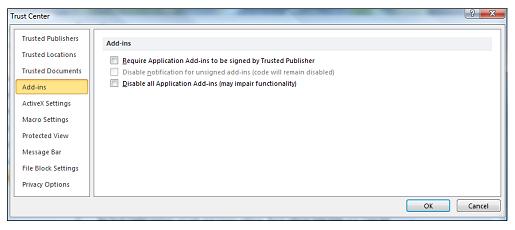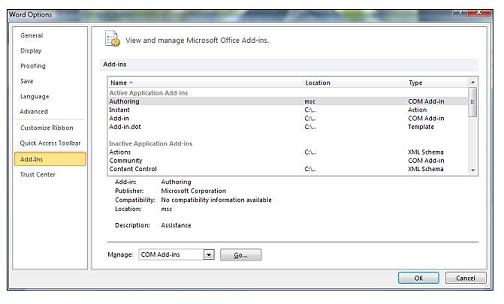View, manage, and install add-ins in Office programs
When you enable an add-in, it adds custom commands and new features to Office programs that help increase your productivity. Because add-ins can be used by hackers to do malicious harm to your computer, you can use add-in security settings to change their behavior.
Click a heading below for more information.
Enable an add-in
You can click Enable Content on the Message Bar if you know the add-in is from a reliable source.

View or change add-in settings
You can see and change add-in settings in the Trust Center, descriptions of which are in the following section. Add-in security settings may have been determined by your organization so not all options may be available to change.
-
Click File > Options.
-
Click Trust Center > Trust Center Settings > Add-ins.
-
Check or uncheck the boxes you want.

Add-in settings explained
-
Require Application Add-ins to be signed by Trusted Publisher Check this box to have the Trust Center check that the add-in uses a publisher's trusted signature. If the publisher's signature hasn't been trusted, the Office program doesn't load the add-in, and the Trust Bar displays a notification that the add-in has been disabled.
-
Disable notification for unsigned add-ins (code will remain disabled) When you check the Require Application Extensions to be signed by Trusted Publisher box, this option is no longer grayed out. Add-ins signed by a trusted publisher are enabled, but unsigned add-ins are disabled.
-
Disable all Application Add-ins (may impair functionality) Check this box if you don't trust any add-ins. All add-ins are disabled without any notification, and the other add-in boxes are grayed out.
Note: This setting takes effect after you exit and restart your Office program.
While working with add-ins, you may need to learn more about digital signatures and certificates, which authenticate an add-in, and trusted publishers, the software developers who often create add-ins.
View installed add-ins
-
Click File > Options > Add-Ins.
-
Highlight each add-in to see the add-in name, its publisher, compatibility, it's location on your computer, and a description of its functions.

Note: If your add-in has been blocked by Data Execution Prevention (DEP), you can learn more about DEP in Why is my add-in crashing?
Add-in categories explained
-
Active Application Add-ins Add-ins registered and currently running in your Office program.
-
Inactive Application Add-ins These are present on your computer but not currently loaded. For example, XML schemas are active when the document that refers to them is open. Another example is the COM add-in: if a COM add-in is selected, the add-in is active. If the check box is cleared, the add-in is inactive.
-
Document Related Add-ins Template files referred to by open documents.
-
Disabled Application Add-ins These add-ins are automatically disabled because they are causing Office programs to crash.
-
Add-in The title of the add-in.
-
Publisher The software developer or organization responsible for creating the add-in.
-
Compatibility Look here for any compatibility issues.
-
Location This file path indicates where the add-in is installed on your computer.
-
Description This text explains the add-in function.
Note: Microsoft Outlook has one add-in option in the Trust Center: Apply macro security settings to installed add-ins. InfoPath has no security settings for add-ins.
Manage and install add-ins
Use the following instruction to manage and install add-ins.
-
Click File > Options > Add-Ins.
-
Select an add-in type.
-
Click Go.
-
Select the add-ins to add, remove, load, or upload. Or browse to locate add-ins to install.
How to cancel a purchased add-in
If you've subscribed to an add-in through the Office Store that you don't want to continue, you can cancel that subscription
-
Open the Office application and go to the Insert tab of the ribbon.
-
In the Add-ins group click My Add-ins

-
Choose Manage My Add-ins

-
Click the app you want to cancel and under Action click Manage Subscription.
-
Under the Payment and Billing section choose Cancel Subscription.
-
Click OK and then Continue.
Once that's complete you should see a message that says "You have cancelled your app subscription" in the comments field of your apps list.
Why is my add-in crashing?
Some add-ins might not be compatible with your organization's IT department policies. If that is the case with add-ins recently installed in your Office program, Data Execution Prevention (DEP) will disable the add-in and the program might crash.
No comments:
Post a Comment